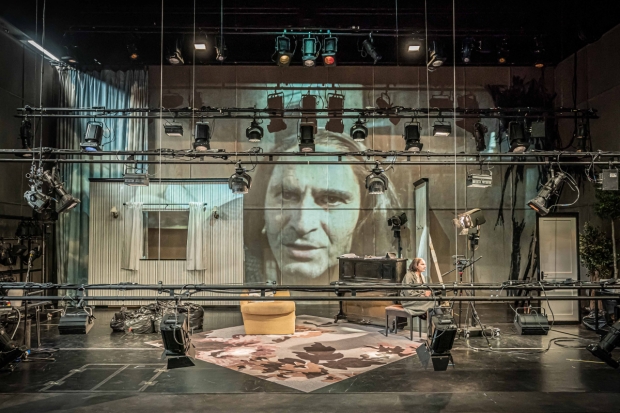The Two Character Play at Hampstead Theatre – review
Tennessee Williams’ piece returns to the Hampstead Theatre after originally premiering at the venue in 1967

© Marc Brenner
Ten minutes before curtain up at the Hampstead Theatre, actor Zubin Varla comes into the auditorium. He starts riffling through bin bags on Rosanna Vize's sound stage set, while fiddling with a mixing desk and a dismounted lighting rig. Cans flutter and organise themselves before Varla's co-performer, Kate O'Flynn, clatters onto the stage. The lights are dragged up into the grid, the show begins.
This is meta-theatre – '60s style. Anyone expecting a cushy family drama cut from the Streetcar or Tin Roof cloth will be sorely disappointed. The two actors, deprived of a company to aid them, try and stage one of Felice's (Varla) plays in front of us, the waiting audience. Fourth walls don't even have a look-in. Felice's text is, with typically self-aware jokiness, titled "The Two-Character Play", and follows two kids, marooned in their home after the tragic death of their parents.
There's a glib, quiet melancholy rather than an anarchic boisterousness to the meta-theatrics here – the pair (inspired by Williams as well as his sister, both of whom had to confront their own mental illnesses) are performing because, in the face of existential dread, it's all they know to do. But then Williams begins to twist his own formula – what happens when escaping into the comfort of one's fictional role means that the character's issues starts to bleed into the "real" world?

© Marc Brenner
Williams is pretty prescient – with the benefit of 35 plus years of cultural output since the play was first written, there's a lot of touchpoints here – Synecdoche, New York, Adaptation, you could even throw WandaVision in at a push. While Felice's play-within-a-play is set in the South, director Sam Yates looks to European theatre tradition to augment his own production – tapping into the likes of Wunderbaum, Toneelgroep, Verdensteatret or, even closer to home, Complicité. Immense help comes from Lee Curran's tactile lighting and Akhila Krishnan's well-suited video.
Varla and O'Flynn carry the two-hour show, in all its absurd abstraction, with typically left-field vivacity – O'Flynn in particular mines the surreality of her character Clare's erratic mental state to bounce between aloofness and comedy. Varla, gnarly, steely, gives Felice a staccato, monotonous directness – plodding on as the metaphoric curtains come down around him. A quaint pleasantness comes as the pair sit together and jam out a pleasant cover of "Love Me Tender" over cigarettes.
But it's easy to spot the holes in the text and the reasons why it never reached the cult status of Williams' earlier classics. The playwright mistakes inertia for the inert – characters are stunned by indecisiveness for most of what is a lengthy second hour, before a final swerve into darker, near-horror gives the show a lively kick just before the close.













